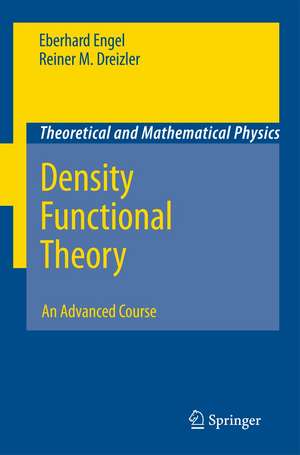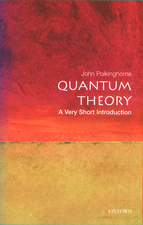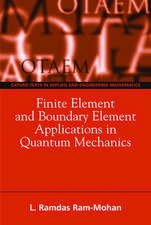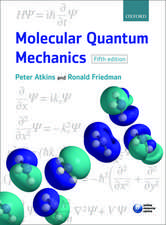Density Functional Theory: An Advanced Course: Theoretical and Mathematical Physics
Autor Eberhard Engel, Reiner M. Dreizleren Limba Engleză Paperback – 21 apr 2013
| Toate formatele și edițiile | Preț | Express |
|---|---|---|
| Paperback (1) | 956.81 lei 6-8 săpt. | |
| Springer Berlin, Heidelberg – 21 apr 2013 | 956.81 lei 6-8 săpt. | |
| Hardback (1) | 960.78 lei 6-8 săpt. | |
| Springer Berlin, Heidelberg – 17 feb 2011 | 960.78 lei 6-8 săpt. |
Din seria Theoretical and Mathematical Physics
- 20%
 Preț: 697.22 lei
Preț: 697.22 lei - 18%
 Preț: 744.84 lei
Preț: 744.84 lei - 20%
 Preț: 699.50 lei
Preț: 699.50 lei -
 Preț: 396.82 lei
Preț: 396.82 lei - 15%
 Preț: 721.06 lei
Preț: 721.06 lei - 18%
 Preț: 1120.68 lei
Preț: 1120.68 lei -
 Preț: 398.35 lei
Preț: 398.35 lei - 15%
 Preț: 643.65 lei
Preț: 643.65 lei - 15%
 Preț: 508.60 lei
Preț: 508.60 lei - 20%
 Preț: 652.54 lei
Preț: 652.54 lei - 15%
 Preț: 646.75 lei
Preț: 646.75 lei - 15%
 Preț: 654.12 lei
Preț: 654.12 lei - 15%
 Preț: 649.87 lei
Preț: 649.87 lei -
 Preț: 396.24 lei
Preț: 396.24 lei - 15%
 Preț: 653.14 lei
Preț: 653.14 lei - 18%
 Preț: 960.78 lei
Preț: 960.78 lei - 15%
 Preț: 529.92 lei
Preț: 529.92 lei - 18%
 Preț: 1127.78 lei
Preț: 1127.78 lei - 18%
 Preț: 1548.71 lei
Preț: 1548.71 lei - 15%
 Preț: 551.53 lei
Preț: 551.53 lei - 18%
 Preț: 1002.75 lei
Preț: 1002.75 lei -
 Preț: 396.02 lei
Preț: 396.02 lei - 15%
 Preț: 648.89 lei
Preț: 648.89 lei - 18%
 Preț: 783.35 lei
Preț: 783.35 lei - 18%
 Preț: 973.38 lei
Preț: 973.38 lei - 18%
 Preț: 907.90 lei
Preț: 907.90 lei - 15%
 Preț: 655.78 lei
Preț: 655.78 lei - 18%
 Preț: 1118.93 lei
Preț: 1118.93 lei -
 Preț: 390.25 lei
Preț: 390.25 lei - 15%
 Preț: 663.79 lei
Preț: 663.79 lei - 15%
 Preț: 653.79 lei
Preț: 653.79 lei - 15%
 Preț: 645.28 lei
Preț: 645.28 lei - 15%
 Preț: 604.23 lei
Preț: 604.23 lei - 15%
 Preț: 639.25 lei
Preț: 639.25 lei - 15%
 Preț: 590.81 lei
Preț: 590.81 lei -
 Preț: 395.25 lei
Preț: 395.25 lei - 15%
 Preț: 589.33 lei
Preț: 589.33 lei - 19%
 Preț: 543.19 lei
Preț: 543.19 lei - 15%
 Preț: 594.24 lei
Preț: 594.24 lei - 18%
 Preț: 911.17 lei
Preț: 911.17 lei - 18%
 Preț: 957.75 lei
Preț: 957.75 lei -
 Preț: 409.13 lei
Preț: 409.13 lei - 15%
 Preț: 532.23 lei
Preț: 532.23 lei
Preț: 956.81 lei
Preț vechi: 1166.84 lei
-18% Nou
Puncte Express: 1435
Preț estimativ în valută:
183.11€ • 198.83$ • 153.81£
183.11€ • 198.83$ • 153.81£
Carte tipărită la comandă
Livrare economică 22 aprilie-06 mai
Preluare comenzi: 021 569.72.76
Specificații
ISBN-13: 9783642267185
ISBN-10: 3642267181
Pagini: 552
Ilustrații: XV, 531 p. 15 illus., 10 illus. in color.
Dimensiuni: 155 x 235 x 29 mm
Greutate: 0.77 kg
Ediția:2011
Editura: Springer Berlin, Heidelberg
Colecția Springer
Seria Theoretical and Mathematical Physics
Locul publicării:Berlin, Heidelberg, Germany
ISBN-10: 3642267181
Pagini: 552
Ilustrații: XV, 531 p. 15 illus., 10 illus. in color.
Dimensiuni: 155 x 235 x 29 mm
Greutate: 0.77 kg
Ediția:2011
Editura: Springer Berlin, Heidelberg
Colecția Springer
Seria Theoretical and Mathematical Physics
Locul publicării:Berlin, Heidelberg, Germany
Public țintă
GraduateCuprins
Introduction.- Foundations of Density Functional Theory: Existence Theorems.- Effective Single-Particle Equations.- Exchange-Correlation Energy Functional.- Virial Theorems.- Orbital Functionals: Optimized Potential Method.- Time-Dependent Density Functional Theory.- Relativistic Density Functional Theory.- Further Reading.- Appendices: Functionals and the Functional Derivative.- Second Quantization in Many-Body Theory.- Scaling Behavior of Many-Body Methods.- Explicit Density Functionals for the Kinetic Energy: Thomas-Fermi Models and Beyond.- Asymptotic Behavior of Quasi-Particle Amplitudes.- Quantization of Noninteracting Fermions in Relativistic Quantum Field Theory.- Renormalization Scheme of Vacuum QED.- Relativistic Homogeneous Electron Gas.- Renormalization of Inhomogeneous Electron Gas.- Gradient Corrections to the Relativistic LDA.- Gordon Decomposition.- Some Useful Formulae.- Index.
Recenzii
From the reviews:
“This book is an introduction to density functional theory (DFT) … . The presentation is … aimed at a general scientific audience (physics, chemistry, etc.). … There are … many interesting choices in the covered topics. … Several appendices help in making the book self-contained.” (Gabriel Stoltz, Mathematical Reviews, Issue 2011 m)
“The book is remarkable for a down-to-earth exposition of DFT that makes it accessible for students specialized in different fields of theoretical physics. … The book may be useful both for beginners as an introduction to DFT and for specialists who would like to expand their view on rigorous foundations of this theory and to keep an eye on the cutting edge of computational methods in condense matter physics.” (Peter Kazinski, Zentralblatt MATH, Vol. 1216, 2011)
“This book is an introduction to density functional theory (DFT) … . The presentation is … aimed at a general scientific audience (physics, chemistry, etc.). … There are … many interesting choices in the covered topics. … Several appendices help in making the book self-contained.” (Gabriel Stoltz, Mathematical Reviews, Issue 2011 m)
“The book is remarkable for a down-to-earth exposition of DFT that makes it accessible for students specialized in different fields of theoretical physics. … The book may be useful both for beginners as an introduction to DFT and for specialists who would like to expand their view on rigorous foundations of this theory and to keep an eye on the cutting edge of computational methods in condense matter physics.” (Peter Kazinski, Zentralblatt MATH, Vol. 1216, 2011)
Textul de pe ultima copertă
Density Functional Theory (DFT) has firmly established itself as the workhorse for the atomic-level simulation of condensed matter phases, pure or composite materials and quantum chemical systems. The present book is a rigorous and detailed introduction to the foundations up to and including such advanced topics as orbital-dependent functionals and both time-dependent and relativistic DFT. Given the many ramifications of contemporary DFT, this text concentrates on the self-contained presentation of the basics of the most widely used DFT variants. This implies a thorough discussion of the corresponding existence theorems and effective single particle equations, as well as of key approximations utilized in implementations. The formal results are complemented by selected quantitative results, which primarily aim at illustrating strengths and weaknesses of a particular approach or functional. DFT for superconducting or nuclear and hadronic systems are not addressed in this work.The structure and material contained in this book allow for a tutorial and modular self-study approach: the reader will find that all concepts of many-body theory which are indispensable for the discussion of DFT - such as the single-particle Green’s function or response functions - are introduced step by step, rather than just used. The same applies to some basic notions of solid state theory, as, for instance, the Fermi surface. Also, the language of second quantization is introduced systematically in an Appendix for readers without a formal theoretical physics background.
Caracteristici
Written by two well-known experts in the field Useful as advanced study text, self-study guide and reference regarding the fundamentals contains advanced level material such as time-dependent and relativistic DFT Includes supplementary material: sn.pub/extras











